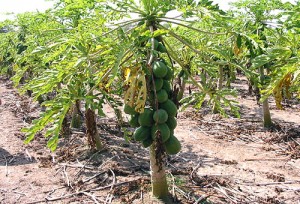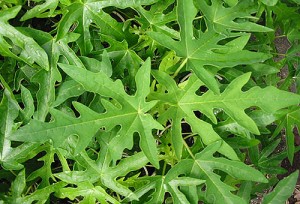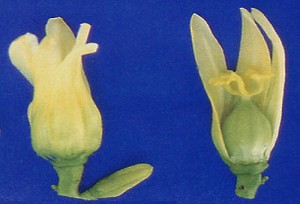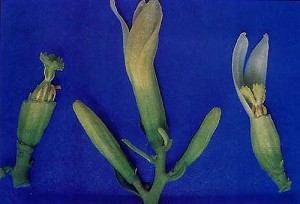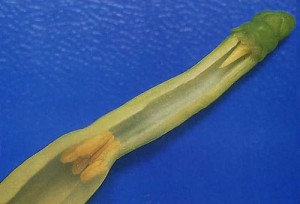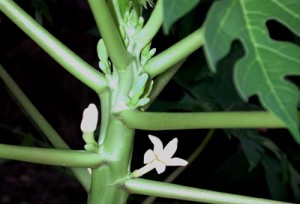Back to > Major Fruits | Minor Fruits | Underutilized Fruits
![]()
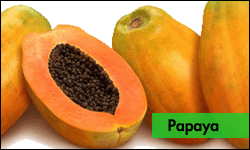 |
||
|
|
||
Name and Botany:
| Family | Genus | Species |
| Caricaceae | Carica – 22 species Facaratia (Jacaratica) – 6 species Farilla (Jarilla) – 1 species Cyclicomorpha – 2 species |
31 species available |
Common Names:
| Southern Asia and East Indies | Kapaya, kepaya, lapaya and tapaya |
| Australia and West Indies | Papaw or paw paw |
| Brazil | Mamao (big breast) or tree melon |
| Spain | Melon zapote, lechosa, papaya (the fruit), papyo @ papyero (the plant), fruta bomba, mammon and mamona |
| France | Papaya (the fruit), papayer (the plant) or “figuier des Iles” |
| Vietnam | Du du |
| New Zealand | Papaw |
| Venezuela | Lechoso (milky) |
| Cuba | Fruita bomba (fruit bomb) |
Botanical Desciption:
Plant: It is a fast growing arborescent herb, with short life; it has single straight or sometimes branched stem reaching 2-10 m height (Papaya tree).When it reaches maturity usually after one year of production, new shoots appear at the lower trunk that develop into branches when the plant reaches it maximum high or when the main top stem is prune off. The stem is cylindrical spongy-fibrous, loose, hollow, gray or gray-brown color, 10-30 cm diameter and toughened by large and protuberant scars caused by fallen leaves and flowers.
The papaya is a polygamous species. The plants may be classified into three primary sex types: 1) male (staminate), 2) hermaphroditic (bisexual), and 3) female (pistillate). In addition, some plants can produce, at the same time, more than one kind of flower. Also, some produce flowers that are not of these basic forms, but exhibit different degrees of maleness and femaleness. This tendency to change in sexual expression seems to be triggered by climatic factors, such as drought and variable temperatures. The tendency to produce male flowers seems to increase at high temperatures. Since male trees are unfruitful and fruit from bisexual plants is preferred in some markets, it is very important to select seed which will produce fruitful trees of the desired type. This can’t be done by simply saving seed from productive open-pollinated plants, but one can predict fairly accurately the progeny by knowing the source of pollen and the kind of flower the fruit came from.
Pollination studies have shown that:
- pistillate flowers pollinated by staminate flowers give equal numbers of male and female progeny;
- pistillate flowers pollinated by pollen from bisexual flowers give an equal number of female and bisexual progeny,
- bisexual flowers either self or crossed-pollinated with other bisexuals give a ratio of one female to 2 bisexual,
- bisexual flowers pollinated by staminate ones produce equal numbers of female, male and bisexual progeny. It is evident that the second and third combinations will produce the maximum number of fruit-bearing plants.
Leaves: The leaves are spirally arranged in a terminal cluster, simple, on petioles 30-70 cm long. The margins of the lobes are very variable, and range from entire to undulate to deeply lobed. The leaves are rounded in outline, 60-90 cm in diameter, alternately arranged, bundled at the apex between stem and branches, long petioles; widely evident, 25-75 cm diameter, smooth, moderately palm shape with thick middle irradiant veins, the base is deeply string shape with over-imposed lobes; from 7-11 large lobed, each with a wide base or slightly constrained and sharp-pointed, and sharp apex. The bundle of leaves is dark green to yellow-green, bright, visibly marked by the off-white nerves embedded and reticulated veins; the underneath surface is pale green-yellow and opaque with visibly prominent vascular structures; the petioles are round and yellow-green, with sporadic purple or violet stains, fistulous form, fragile, 25-100 cm length and 0.5-1.5 cm thick. The lifespan of each leaf is 4 to 6 months.
Flowers: Six types of flowers are known in papaya plant.
a) Typical female flower: It is a rather large flower of conical shape when closed, when open, its five petals spread from the base. The ovary is large with circular and smooth or slightly undulated. Fruits produced by this flower are spherical or ovoid in shape.
b) Similar to the above when closed: but this type has five short anthers, which correspond in their orientation with the five petals that also spread from the base. The ovary has five deep longitudinal grooves that remain until maturity. Fruit develop a form from globular to egg-shaped.
c) Hermaphrodite intermediate flower: The organization is undefined; petals may be fused up to two thirds of their length or free from the base. The number of anthers ranges from two to ten; the carpels range from five to ten, with different degrees of fusion. This type of flower produces irregularly-shaped fruit known as carpelodic (cat face), with little commercial value. These flowers appear more frequently when ambient temperatures are 24.5 °C during the day and 15.5 °C at night.
d) Hermaphrodite elongated flower: Petals of this type of flower are fused from one fourth to three fourths of their total length; ten anthers are observed, five long and five short. The ovary is long and when it contains five or more carpels, the form of the fruit varies from cylindrical to pear-shape. From the different types of hermaphrodite flowers, this is the most commercially important.
e) Hermaphrodite sterile flower: It is a flower that resembles the former, but does not develop an ovary and hence it is sterile, warm temperatures or water stress. Due to the fact that it produces pollen only, it may be considered a functional male flower.
f) Typical male flower: This type of flower has a long and thin corolla contain anthers in two series of five; one series longer than the other. They have a rudimentary pistil no stigma and are non-functional.
In nature, these plants are dioecious: male and female flowers are found on separate plants. Male flowers are morphologically distinct from female flowers. Male inflorescences are borne in many-flowered panicles of cymes on horizontal or pendent stalks to 1 m long. The flowers are yellowish, 2-4 cm long. The petals are fused into a long tube, have 10 fertile stamens, and a rudimentary, non-functional ovary. Female inflorescences are much shorter –only 3-4 cm long– and have fewer flowers. Female flowers are larger, usually white or cream in colour, with five free petals. There are no stamens, but a large ovary with 5 fan-shaped stigmas.
In cultivation, there are many intermediate forms, including bisexual flowers. At least 15 different flower forms have been named (e.g. Pentandria–5 stamens and a functional ovary) and, because they are correlated with different fruit characteristics, some forms, have been selected by breeders. Environmental factors may also influence sexual expression, and the sexuality of a plant may change seasonally or over the course of its lifetime. Thus the sexuality of any one plant in cultivation depends on a complex mix of genetic, developmental, and environmental factors.
Female flowers have a calyx formed by a crown or five-pointed star easy to differentiate. On top of the calyx, the ovary is located by five yellowish sepals (when young, they show a purple coloration. There are five round-shaped yellow stigmas. Fruits from this flower are usually large and balloon-like.
Hermaphroditic flowers have both sexes and the tree bearing these has three different types of flowers. One is called pentandria, resembling a female flower, but when petaks are taken apart 5 anthers are seen and the ovary is lobed. Fruit are balloon-shaped and lobed. A second type of flower is called elongata and bears 10 anthers, arranged in two sets, the flower is elongated and cylindrical as the ovary and produce elongated fruits. The last type is intermedia or irregular, which is not a well-constituted flower and produces malformed fruit.
Male flowers grow along peduncles measuring over half a meter length and at the end there are bundles formed by 15-20 small flowers. These flowers are constituted by a long tube formed by fused petals, inside which there are 10 anthers, arranged in two sets of five. The flower has a small rudimentary pistil and has no stigmas. No fruit are usually produced, or if formed these are elongated and of low quality.
Fruit: An ovoid-oblong berry pyriform or almost cylindrical, large, fleshy, juicy, grooved along the upper longer side, green yellow to yellow or yellow-orange colour when ripen, single cell of orange or redish internal colour with many parietal seeds and a length of 10-25 cm or longer and 7-15 cm or more of diameter. Generally, the fruit is melon-like, oval to nearly round, somewhat pyriform, or elongated club-shaped, 15-50 cm long and 10-20 cm thick; weighing up to 9 kg. Semi-wild (naturalized) plants bear miniature fruits 2.5-15 cm long. The skin is waxy and thin but fairly tough. When the fruit is green and hard it is rich in white latex. As it ripens, it becomes light or deep-yellow externally and the thick wall of succulent flesh becomes aromatic, yellow, orange or various shades of salmon or red. It is then juicy, sweetish and somewhat like a cantaloupe in flavor; in some types quite musky. Attached lightly to the wall by soft, white, fibrous tissue, are usually numerous small, black, ovoid, corrugated, peppery seeds about 3/16 in (5 mm) long, each coated with a transparent, gelatinous aril. [see “wax” 2 and sunrise “solo” 3 papaya varieties].
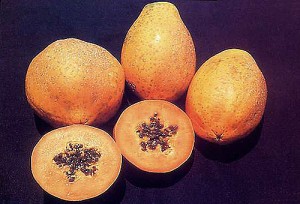 “Wax” papaya variety 2 |
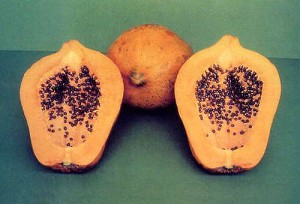 “Sunrise solo” papaya variety 3 |
Reference:
- Chong, S.T., R. Prabhakaran and H.K. Lee. ISHS Acta Horticulturae 787: International Workshop on Tropical and Subtropical Fruits.
- Lamberts, M. and J.H. Crane. 1990. Tropical fruits. p. 337-355. In: J. Janick and J.E. Simon (eds.), Advances in new crops. Timber Press,Portland,OR.
- Morton, J. 1987. Papaya. p. 336–346. In: Fruits of warm climates. Julia F. Morton,Miami,FL.

